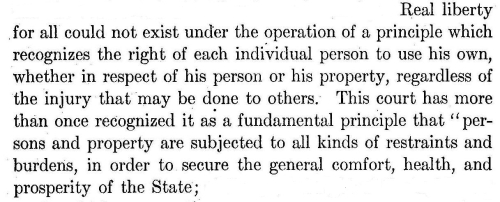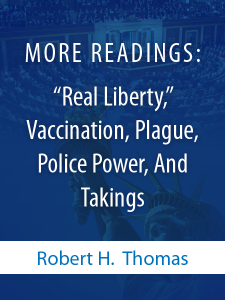
Here’s what we’re reading today, spurred by the headlines swirling around all of us. Mostly cases about the role of the courts when government curtails liberty or property rights under its police or emergency powers. We’ve now seen the first lawsuit claiming that an order to shut down businesses is a due process violation and is a regulatory taking requiring compensation, and we’re hearing about official quarantines, citations for people violating stay-home orders, and the like.

We started with the vaccination cases. These got us to thinking that if the government can for the most part force people who don’t want vaccinations to get vaccinations (violating their bodily integrity), then how will a court treat seemingly less-invasive intrusions into liberty or property in the name of public health?
In Jacobson v. Massachusetts, 197 U.S. 11 (1905), the Court distinguished “an absolute right in each person to be, at all times and in all circumstances, wholly freed from restraint,” with what it labeled “[r]eal liberty” –
Real liberty for all could not exist under the operation of a principle which recognizes the right of each individual person to use his own, whether in respect of his person or his property, regardless of the injury that may be done to others. This court has more than once recognized it as a fundamental principle that “persons and property are subjected to all kinds of restraints and burdens, in order to secure the general comfort, health, and prosperity of the State;
…
It is then liberty regulated by law.
Id. at 26, 27 (footnote omitted). The Court based its reasoning on public “self-defense,” noting that “a community has the right to protect itself against an epidemic of disease which threatens the safety of its members.” Id. at 27.
In other words, that old principle that Justice Scalia referred to in Lucas as a “background principle[] of the state’s property and nuisance” law. If you can’t protect your body from being physically invaded, a court isn’t likely to conclude that you can use your property in a way that is harmful to others. And although the government’s powers cannot be exercised in “an arbitrary, unreasonable manner,” or “go so far beyond what was reasonably required for the safety of the public,” the courts won’t seriously question another branch’s conclusions. Jacobsen, 197 U.S. at 28,
That conclusion about who gets to determine that your use of property is, in fact, harmful to others remains valid today. As we’ve seen in these cases (and in this case, too), the courts are going to be even more deferential to the authorities’ assertions that “X measure is necessary to preserving the public health” than they are in the usual circumstances. On a good day, courts are already super deferential, and we can’t imagine that the courts would be less deferential in the current situation. (Joe Hadacheck was not available for comment.)
But what about those cases where the courts have struck down measures that were done seemingly to protect the public health, such as a quarantine to battle the bubonic plague? In Wong Wai v. Williamson, 103 F. 384 (N.D.Cal. 1900) and Jew Ho v. Williamson, 103 F. 10 (N.D.Cal. 1900), for example, the court enjoined enforcement of a San Francisco ordinance that was based on city officials’ belief “that danger does exist to the health and citizens of the city and county of San Francisco by reason of the existence of germs of the [plague] remaining in the district hereafter mentioned [Chinatown].” Jew Ho, 103 F. at 12. San Francisco supported the ordinance by referring to Mugler v. Kansas, 123 U.S. 623 (1887) and the city’s police powers. Why wasn’t that the trump card?
The plaintiffs in those case alleged the ordinance wasn’t reasonably designed to protect the public health, but really was aimed at Chinese people. We saw this same vibe in an earlier Hawaii decision which upheld a restriction on commercial laundries in Honolulu’s Chinatown, although the racial bias argument was apparently not developed in that case. The California federal court, by contrast, considered the plaintiffs’ arguments that what looked like a public health ordinance was, in reality, racial discrimination:
The evidence here is clear that this is made to operated against the Chinese population only, and the reason given for it is that the Chinese may communicate the disease from one to the other. That explanation, in the judgment of the court, is not sufficient. It is, in effect, a discrimination, and it is the discrimination that has frequently been called to the attention of the federal courts where matter of this character have arisen with respect to Chinese.
Jew Ho, 103 F. at 23 (citing Yick Wo v. Hopkins, 118 U.S. 356 (1886)).
Ah, but you say, a takings claim does not seek to enjoin the government action because it is unreasonable or discriminatory, but instead asks only for compensation as cost-spreading measure for an otherwise valid exercise of governmental power … what about that?
A good exemplar of how courts will likely react to these type of arguments is the Minnesota Supreme Court’s ruling in Zeman v. City of Minneapolis, 552 N.W.2d 549 (Minn. 1996) (thanks to a learned Minneapolis colleague for sending this one our way). There, the court reversed the court of appeals’ conclusion that the city’s revocation of Zeman’s rental licenses because his property had been the subject of multiple disorderly use complaints was a Penn Central taking.
The court’s analysis is worth quoting at length:
The city argues that the ordinance at issue here is a valid exercise of municipal power to ameliorate a nuisance, namely criminal activity in a residential neighborhood. Zeman does not challenge this characterization, but points to the fact that the city erroneously employed its own ordinance. This seems to us to be irrelevant: if the ordinance indeed is a proper effort to protect the health, morals, or safety of the community which has the effect of prohibiting a particular use of a property, then there will be no taking. See Mugler, 123 U.S. at 661-62.
The first two of the Penn Central factors involve the economic impact of the regulation on the person suffering the loss and the extent to which the regulation interferes with distinct investment backed expectations. Penn Central, 438 U.S. at 124-25. Certainly, as Zeman’s witness testified, the economic impact on Zeman has been substantial; the best use for his property is as an apartment building, and without a rental dwelling license he cannot operate it as such. Moreover, rezoning of the property for another use is unlikely and, given the economically depressed nature of the neighborhood, so too would be locating a buyer. Also, as Zeman has operated this property as a rental dwelling since acquiring it in 1975, it would appear that he has some investment-backed expectations in its use as such. Thus, the first two Penn Central factors militate towards a decision in Zeman’s favor.
Consideration of the third factor, the character of the government action, however, favors the city. Under this factor, we must examine the regulation at issue, with emphasis on its purpose and the possibility of achieving that purpose with this regulation. While this is always an important consideration in a takings analysis, in cases involving a regulation aimed at the protection of the public health and safety, it becomes paramount. If the state regulation appears genuinely designed to prevent harm to the public and is likely to achieve that goal and the harm suffered by the property owner does not appear to be one that should be borne by the entire community, we will not find a taking. See, e.g., Mugler, 123 U.S. at 661-62; Keystone Bituminous Coal Ass’n v. DeBenedictis, 480 U.S. 470, 488-93 (1987).
Mugler held that a state could prohibit a use of a property that it determined to be injurious to community health, morals, or safety and, therefore, although enforcement of a statute prohibiting the manufacture of alcohol against Mugler, a beer maker, would substantially depreciate the value of his property, no taking occurred. Mugler, 123 U.S. at 656-57, 668-69. Since Mugler, the Court has upheld as valid state regulatory efforts — denying compensation for alleged takings — the destruction of infected trees jeopardizing local orchards, Miller v. Schoene, 276 U.S. 272, 279-80 (1928), the banning of brickyard plant operations in urban areas, Hadacheck v. Sebastian, 239 U.S. 394, 410-11 (1915), and strict limitations on coal mining activities, Keystone, 480 U.S. at 485.
A harm-prevention regulation, if not a ruse for a state purpose other than protecting the public from noxious harm or illegal activity, is a powerful rationale militating against finding a taking. See Bruce W. Burton, Regulatory Takings and the Shape of Things to Come: Harbingers of a Takings Clause Reconstellation, 72 Ore. L. Rev. 603, 618-19 (1993). A reviewing court must look to the nature of the regulation with an eye on its purpose and the probability of achieving that purpose with this regulation. If the regulation is drawn to prevent harm to the public, broadly defined, and seems able to achieve this goal, then a taking has not occurred. See, e.g., Keystone, 480 U.S. at 488-93.
Zeman, 552 N.W.2d at 553-54.
We’re thinking that if the government were to physically occupy or appropriate property during a health emergency, if its measures are beyond the government’s power, or if there’s proof that the public health isn’t the real reason but is a pretext, that these situations would likely be subject to a much different analysis. See, e.g., De Keyser’s Royal Hotel, Kimball Laundry. and Youngstown Sheet and Tube, for example. But your typical regulatory takings situation is going to be an uphill climb.
This article was originally posted on Inverse Condemnation and was written by Robert Thomas. For more information about Robert Thomas and Inverse Condemnation, visit https://www.inversecondemnation.com/.
